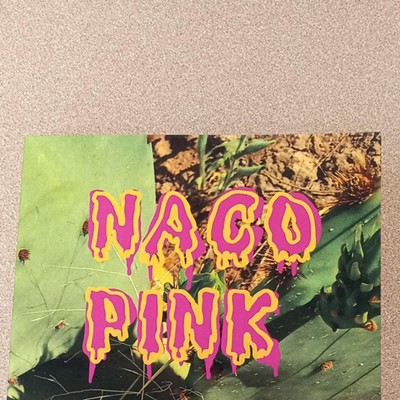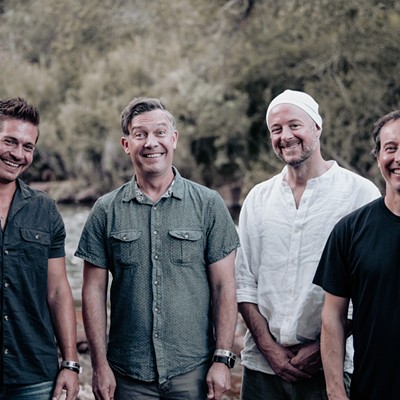If someone told you there was an exhibition of paper works at the UA Poetry Center, you'd mostly likely expect to see books. With poems in them. Written on paper.
You wouldn't anticipate seeing 16 black clay ravens perched on real-life thorny twigs, as you do in Kristie Atwood's "Poe and the Hollow Crown."
Mind you, there is a book involved. Those birds are playing chess on a fat volume of Edgar Allan Poe's "Complete Works," open to pages from the short story "The Pit and the Pendulum." Atwood says in an artist's statement that her startling piece is half inspired by another book, Rachel Carson's "Silent Spring," the 1962 volume that issued a clarion call to save the environment—and noted that pollution was particularly damaging to birds.
Poe's doomed ravens aside, there are classic artist books in PaperWorks: Between Word and Images, an exhibition that ends its summer run next week. These one-of-a-kind books have luscious textured paper hand-sewn into bindings, lyrical poems and painterly or photographic images.
"Liminal Spaces," just for instance, consists of three lovely volumes of poems and linocut prints of flowers, created collaboratively by Judy Derrickson, Jo Andersen, Vanessa Dearing and Chris Mann. The page that's open in the display case has gorgeous abstracted golden flowers printed against a teal green background, made by Derrickson.
Deb Hilpert went topical in her somber "A Migrant's Path," a hand-sewn book that records her January 2015 hike along a well-worn migrant trail in the Arizona borderlands. She photographs the belongings the travelers left behind—a backpack, an empty food can, a blanket—and imagines the travails of their owners in short poems in English and Spanish: "Maria, 44: nowhere to turn, stomach growls."
What makes this small exhibition exhilarating is that the 18 artists, all members of the adventurous Tucson collective PaperWorks, forge bravely into all media. They use paper, to be sure, but they also deploy found objects, including Atwood's sharp sticks, fragments of film negatives and old documents, along with clay, ink, photographs and paint.
Each of the contributing artists has stuck to the theme of marrying words to images, but some haven't made books at all.
Margaret Suchland, better known as an encaustics painter, has made collages that hang in frames on the wall. She's a gatherer of ephemera, and she puts together snippets of film negatives, old texts and documents—one work uses a page from a dictionary as a base—arranging them into arresting abstractions. Then she tops them with her own black-ink drawings of letters and invented words.
Poet Carley Gomez and book artist Levi Sherman exhibit a deck of 52 homemade playing cards. On the back of the cards, in the tiniest typeface possible, they've told the "non-linear" tale of the life of a troubled man, printing fragments of his memories, of a mother who was a "prodigy of sophistication" and of a glance that was "trashed in a blink." The flip side of the cards provide a canvas for '50s-style wallpaper patterns colored in mustard and lime green, designs meant to evoke the man's lost childhood.
Even the works that are books barely meet the traditional definition. "Bloodstone Bhava" by Anita Rankin is a whirligig, its pages swinging out in a lively circle from a central core.
Perhaps the most beautiful piece in the show is the accordion book "Canyon Voices." Made of a single long stretch of paper and board, it can be extended out maybe 5 feet and then folded back to the size of a single page. The format, chosen by artists Mary Jane Henley and Carolyn DuPont, is an apt match for their subject, Echo Canyon in New Mexico's O'Keeffe country.
The pair photographed the region's endless skies and infinite horizons, and then translated the images into book-appropriate gravure prints. The landscape is rendered in wonderfully subtle tones of pale sepia that evoke the past, particularly the photos of the 19th century Western expedition photographers.
The last picture in the book, a view of massive clouds above a sliver of earth, is accompanied by a haiku: "bubbling cumulus/floating up toward heaven/celestial waltz."












